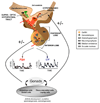Trafficking of G-protein-coupled receptors to the plasma membrane: insights for pharmacoperone drugs
- PMID: 20005736
- PMCID: PMC2831145
- DOI: 10.1016/j.tem.2009.11.003
Trafficking of G-protein-coupled receptors to the plasma membrane: insights for pharmacoperone drugs
Abstract
G protein-coupled receptors (GPCRs) are among the most common potential targets for pharmacological design. Synthesized in the endoplasmic reticulum, they interact with endogenous chaperones that assist in folding (or can retain incorrectly folded proteins) and are transferred to the plasma membrane where they exert their physiological functions. We summarize trafficking of the gonadotropin-releasing hormone receptor (GnRHR) to the plasma membrane. The trafficking of GnRHR is among the best characterized due in part to its small size and the consequent ease of making mutant proteins. Human mutations that cause disease through the misrouting of GPCRs including GnRHR are also reviewed. Special emphasis is placed on therapeutic opportunities presented by pharmacological chaperone drugs, or pharmacoperones, that allow misrouted mutants to be routed correctly and restored to function.
Copyright 2009 Elsevier Ltd. All rights reserved.
Figures



References
-
- Lin JC, Liu HL. Protein conformational diseases: from mechanisms to drug designs. Curr Drug Discov Technol. 2006;3:145–153. - PubMed
-
- Castro-Fernandez C, et al. Beyond the signal sequence: protein routing in health and disease. Endocr Rev. 2005;26:479–503. - PubMed
-
- Chiti F, Dobson CM. Protein misfolding, functional amyloid, and human disease. Annu Rev Biochem. 2006;75:333–366. - PubMed
-
- Gregersen N. Protein misfolding disorders: pathogenesis and intervention. J Inherit Metab Dis. 2006;29:456–470. - PubMed
-
- Beglova N, Blacklow SC. The LDL receptor: how acid pulls the trigger. Trends Biochem Sci. 2005;30:309–317. - PubMed
Publication types
MeSH terms
Substances
Grants and funding
LinkOut - more resources
Full Text Sources

